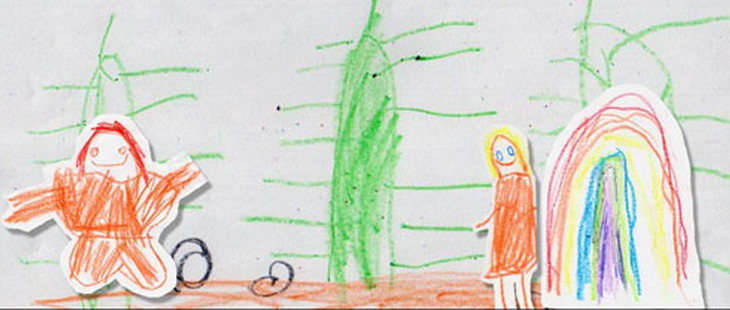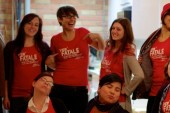
Sissy’s Magical Ponycorn Adventure, designed by Ryan Creighton and his five-year-old daughter.
I love video games enough that I’ve managed to jumble together the resemblance of a career covering the industry as a writer and journalist. I play games for work and for fun, I write about games for work and for fun.
What I don’t love, though, is making them. No matter how supposedly intuitive the tools are – whether it’s the Stephen Fry-narrated level creation in LittleBigPlanet or the ability to make goofy microgames in WarioWare DIY – the process of designing a game has never appealed to me. I’d much rather play around in virtual worlds than make them.
So it was with some trepidation that I sat in front of a computer at George Brown College one weekend in May with a particular goal in mind: create a game, by myself, in just three days.
And I wasn’t alone. Far from it, in fact. I was just one of a few hundred people squeezed into the Autodesk building at George Brown with the intention of building a game from scratch. Some, like me, were doing it solo, while others formed teams of varying sizes. And some, like me, were making a game for the very first time, while others were industry professionals behind games that have been both critical and commercial successes.
Now in its sixth year, Toronto Game Jam, or TOJam, just keeps growing. At the first jam in 2006, 35 people showed up and 10 games were completed. This year more than 200 people showed up and created more than 50 games. The building was so packed that when organizers Rob Segal and Jim and Emilie McGinley wanted to address everyone they had to do it outside at the building’s loading dock, much to the chagrin of security.
It was here that Jim imparted words of advice to those assembled. He told everyone not to worry about making a good game “because there are lots of good games.” Instead, just try and make something memorable, even if it’s only a few seconds long. Arguably more importantly, he warned everyone of the dangers of drinking too much of the complimentary Red Bull.
TOJam epitomizes the city’s game development community. The organizers and volunteers work tirelessly and established companies use the event as a chance to give back. Successful local developers like Matt Rix (Trainyard), Get Set Games (Mega Jump), and Metanet Software (N+) sponsored various aspects of the jam, making sure that everyone stayed full of Chinese food, candy and caffeine.
That’s the thing about the jam: everyone gets involved. In a lot of ways TOJam – and the city’s game development community at large – began as a response to the absence of major game studios in Toronto. While Montreal and Vancouver became industry leaders, attracting massive studios creating blockbuster hits, Toronto was left behind, forcing game creators to do their own thing, and ultimately making the city an enviable hotbed of independent game development. TOJam exemplifies this DIY, indie spirit.
The community is also a tightly connected group. Indie developers mingle with folks from big studios (which are now starting to pop up, spearheaded largely by Ubisoft’s Junction area office), who are joined by journalists and myriad enthusiasts. Where else could you have developers who’ve created million selling games work alongside students and clueless journalists like myself?
Looking around at the various faces bathed in the constant glow of massive monitors, two things were clear: everyone was exhausted and everyone was having a good time. People would take breaks to show off their games to one another, beaming with pride, whether it was an old-school game about a shark made of bacon or a father-daughter team working together on a game about unicorns. These people just love games. Some even came armed with pillows and sleeping bags so that they could spend as much time working as possible. A planned movie night was cancelled because no one wanted to leave their computers. Too much to do, too little time.
*
My grand scheme was to recreate the beloved paintball episode of Community in interactive fiction form. I thought it’d be hilarious. I also figured that without having to worry about creating a story and characters from scratch, I’d be free to focus on the actual design aspect of the experience. But I soon realized that taking a linear story from a television show and turning it into a non-linear, interactive game isn’t so easy. It also didn’t help that I had little to no idea of what I was doing, literally spending hours trying to figure out something as simple as how to create a door that you can walk through.
Solution? My version of Greendale Community College was decidedly open concept.
But for the first little while I just sort of stared at the screen, not knowing where to start. I futzed around a bit with the tutorials for the program that I was using to create my text adventure, but I didn’t really do much designing or writing. I didn’t know where to start. Worse still, I felt out of my element, like I didn’t really belong.
I looked to the side and saw a screen full of lovely, old-school 2D art. I looked behind and saw actual 3D models on a monitor, animating and everything. I checked Twitter and saw people posting in-progress screenshots of games that looked really polished and beautiful. And then I looked at my screen and saw a few lines of boring text. My confidence wasn’t exactly high.
That’s when the communal aspect of the event took hold of me. At one point early on, Jim McGinley came by to check on me and offer some help. I’d run into other developers around the halls and they’d tell me how great it was that people like me were taking an interest in making games. While getting some much needed coffee I bumped into Craig Adams, the creative mind behind the much touted iPad title Superbrothers: Sword & Sworcery EP, and a designer who I’ve written about. Jokingly, he told me that he couldn’t guarantee that he’d give my game a good review.
I felt relaxed. I felt confident. In this place, I figured, I was essentially on the same level as the guy who created Sworcery. And more importantly, I remembered that I didn’t have to worry about creating something amazing. This was my first game after all.
I just had to create something.
*
Massacre at Cuttlefish, by Armasquiddon
There are some who wonder what the point is of cramming a whole bunch of people into a room, pumping them full of Red Bull, and then giving them the incredibly difficult task of completing an entire game in just a few days. I know, because prior to this experience I was one of them. It didn’t really make sense to me. But the answer is, in retrospect, pretty obvious: it’s all about motivation.
If I were to try to do the same thing at home I would’ve given up before finishing the tutorial. There would’ve been no bumping into people in the halls to lift my spirits, no light-hearted jokes to calm my nerves. Being surrounded by so many like-minded people similarly focused on the same task proved an incredible motivator.
In the end I did finish a game, but as inspired as I still wasn’t completely in the spirit of TOJam. When people asked me how my game was, both before and after it was finished, I went the self-deprecating route. “Oh, it’s awful,” I’d say smiling. “Like, really, really terrible.” I’d forgot that this was the part that didn’t matter. It wasn’t until after TOJam had ended that I really got it.
I was chatting briefly over Twitter with Miguel Sternberg, a local indie developer who creates games for a small, two-man studio called Spooky Squid. Again, he said how happy he was that journalists like me were getting into the game-making spirit. I said he wouldn’t be so happy if he had to play my terrible game.
“That’s a success!,” he said. “TOJam is about personal challenge and the process of trying to make something, less about the final project.”
A little while after that, Jim McGinley sent me an email saying “I can’t wait to play your monstrosity.”
So, yeah, I did create what basically amounts to some awful interactive fan fiction about a sitcom. But now maybe I’m not so embarrassed.














